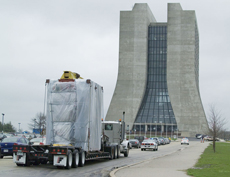 Savings by building a neutrino detector with nearly all recycled parts: $3.2 million.
Savings by building a neutrino detector with nearly all recycled parts: $3.2 million.
Savings by constructing a small experiment hall: $3 million.
Being able to design, build, and tear down an experiment in less than three years: priceless.
In an era when high-energy physics experiments, and sometimes their approval processes, can last decades, it's an increasing rarity to find a project that lets collaborators work on all aspects of the research from start to finish.
"It's good to save money, but it also saves time, which is good so that young students working on their PhDs have time to build an experiment, take the data, and do analysis," says SciBooNE cospokesperson Tsuyoshi Nakaya.
The 65 collaborators on SciBooNE, a low-energy range neutrino experiment at Fermi National Accelerator Laboratory, last week celebrated the completion and decommissioning of one of high-energy physics shortest and cheapest fixed-target experiments.
The international collaboration of Japanese, Americans, British, Spanish, and Italians formed in the summer of 2005 and had a detector commissioned by May 2007. Data-taking ended this month.
The entire experiment cost $1.2 million, a drop in the bucket for high-energy physics research. The majority of that cost, $850,000, came from constructing a building to house the detector, but even that was a steal. The collaboration made the building as small as possible by utilizing other areas in the laboratory to assemble the three subdetectors. Constructing an experiment hall large enough for assembly would have pushed the construction cost from $800,000 to nearly $3 million. The experiment building is so small that the collaboration had to order a portable toilet for use during the nearly three weeks of decommissioning.
All but a handful of parts were borrowed to build the subdetectors, earning the collaboration a top-notch environmental protection award.








